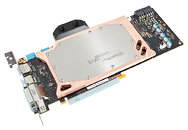- Joined
- Oct 9, 2007
- Messages
- 47,692 (7.42/day)
- Location
- Dublin, Ireland
| System Name | RBMK-1000 |
|---|---|
| Processor | AMD Ryzen 7 5700G |
| Motherboard | Gigabyte B550 AORUS Elite V2 |
| Cooling | DeepCool Gammax L240 V2 |
| Memory | 2x 16GB DDR4-3200 |
| Video Card(s) | Galax RTX 4070 Ti EX |
| Storage | Samsung 990 1TB |
| Display(s) | BenQ 1440p 60 Hz 27-inch |
| Case | Corsair Carbide 100R |
| Audio Device(s) | ASUS SupremeFX S1220A |
| Power Supply | Cooler Master MWE Gold 650W |
| Mouse | ASUS ROG Strix Impact |
| Keyboard | Gamdias Hermes E2 |
| Software | Windows 11 Pro |
To efficiently cool down the GeForce GTX TITAN graphics card, Aqua Computer offers the new Kryographics series full cover blocks. Other than the old aquagrafx series the new blocks feature wider openings at the side of the copper base and a revised connection terminal to optimize the flow rate.
The 10 mm thick copper base covers the GPU, RAM and voltage regulators. All surfaces with contact to the card are highly polised to 1/1000mm. The top is made of stainless steel and comes with a laser engraved logo. Above the GPU the block uses a 0.25mm micro structure which results in a delta of 10°C between the GPU and water in our internal tests with Furmark. Due to the precise CNC production process the RAM chips can be used with thermal grease which offers a much better heat transfer over thermal pads.

The block will be available in four different variants: copper or nickel plated copper with a stainless steel top, and both blocks also with a Plexiglas top surrounded by a stainless steel frame.
The Kryographics GTX TITAN with copper base ans stainless steel top is in production right now and will be available within the week. Orders are already possible, the block costs 89,90 Euro (incl. 19% VAT). The other three variants will be available by mid March, prices are to be announced.
View at TechPowerUp Main Site
The 10 mm thick copper base covers the GPU, RAM and voltage regulators. All surfaces with contact to the card are highly polised to 1/1000mm. The top is made of stainless steel and comes with a laser engraved logo. Above the GPU the block uses a 0.25mm micro structure which results in a delta of 10°C between the GPU and water in our internal tests with Furmark. Due to the precise CNC production process the RAM chips can be used with thermal grease which offers a much better heat transfer over thermal pads.

The block will be available in four different variants: copper or nickel plated copper with a stainless steel top, and both blocks also with a Plexiglas top surrounded by a stainless steel frame.
The Kryographics GTX TITAN with copper base ans stainless steel top is in production right now and will be available within the week. Orders are already possible, the block costs 89,90 Euro (incl. 19% VAT). The other three variants will be available by mid March, prices are to be announced.
View at TechPowerUp Main Site






